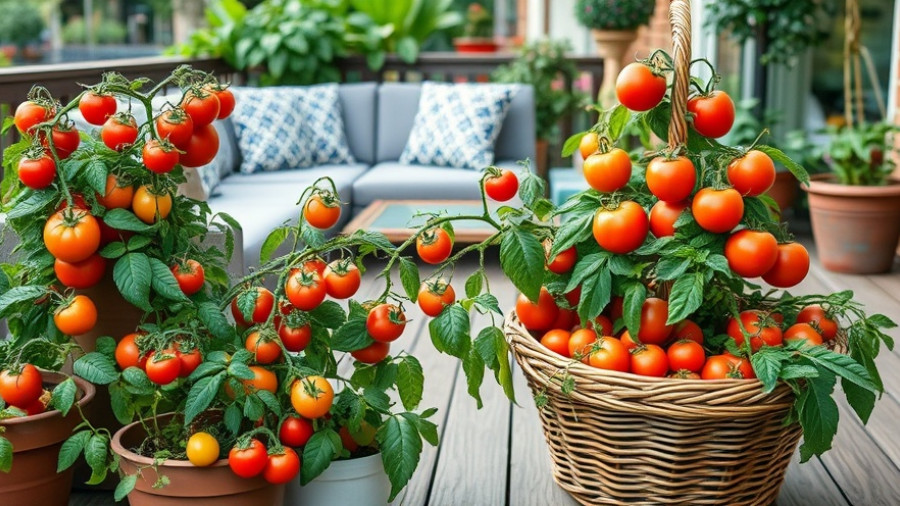
Transform Your Garden: The Top Trends for 2026
As we step into 2026, homeowners are looking beyond mere backyard aesthetics. The garden is becoming an extension of our living spaces, a sanctuary for relaxation, and a canvas for creativity. Emerging trends demonstrate an exciting renaissance in gardening, where beauty intersects with functionality. Here’s a glimpse into the leading garden trends that will shape the outdoor spaces of the year to come!
Embracing Edible Elegance in Outdoor Living
The rise of edible gardens exemplifies a growing trend where functional meets fashionable. Homeowners increasingly seek to cultivate their produce while enhancing their garden aesthetics. This year, expect to see compact fruit trees and vibrant herbs as integral parts of garden designs, transforming spaces into lush and nourishing retreats.
According to landscape experts, blending beauty with nourishment is not just a trend but a necessity. Popular plants like columnar apples and dwarf figs are designed for limited space but high yield, allowing those with small patios to grow their own food without overcrowding. Herbs such as rosemary and basil are also being utilized not merely for flavor but as decorative edging, bridging the gap between culinary and ornamental gardens.
Patio Culture: Expanding Outdoor Living Spaces
Patios have evolved into immersive living areas, designed with character and comfort. Homeowners are transforming these spaces into extensions of their homes by incorporating fragrances, textures, and seasonal plantings. This pushes the envelope beyond basic tables and chairs to create inviting atmospheres where families can unwind.
Lightweight, movable containers allow for easy seasonal rearrangements, encouraging a dynamic design that changes with the seasons. Vibrant plants like jasmine and mandevilla serve dual purposes as both decorative elements and relaxing fragrances, emphasizing a holistic approach to garden and patio design.
Natural Aesthetics: The Wild and Refined
The trend towards native and pollinator-friendly gardens is reshaping landscapes. These designs focus on creating habitats that provide both food and shelter for local wildlife. By selecting native plants that thrive in local conditions, gardens not only enhance biodiversity but also reduce maintenance needs.
This approach promotes sustainability and aesthetics, merging natural beauty with functionality. Gardeners are encouraged to explore increasingly refined wildscapes—areas that celebrate organic growth while also being structured and intentional.
Color and Texture: The New Palette for 2026
The color schemes of gardens in 2026 will take inspiration from the rich jewel tones dominating interior design. Transitioning away from pastels, gardeners will embrace deep, saturated colors that stand out in sunlight and create bold, lively spaces.
Introductions of new plant varieties are set to emphasize these colors. Varieties like sweetshrub and unique heirloom bulbs will add drama and richness to gardens, pushing the boundaries of traditional planting palettes.
Making Gardening Accessible: Small Spaces and Minimal Maintenance
With more people dwelling in urban settings, gardening is becoming more compact. People are opting for micro-gardening solutions that deliver big visual impacts in less space. This trend caters to the need for lush gardens despite limited room, focusing on curated selections of plants that are aesthetically pleasing and easy to maintain.
Gardening experts note the importance of choosing plants that reduce the time spent on upkeep, favoring robust species that thrive with minimal interference. Varieties like boxwoods and flowering shrubs not only simplify maintenance but also add elegance to even the smallest outdoor corners.
Sustainable Practices: Eco-Conscious Gardening
As environmental awareness continues to grow, gardeners are focusing on sustainability. Strategies such as using native plants, incorporating climate-resilient crops, and reducing chemical use in gardening practices are on the rise. Edibles like fava beans exemplify this trend as they are not only hearty but also enrich the soil.
This commitment to eco-friendly practices includes the thoughtful placement of flora to benefit local ecosystems, ensuring that gardens support rather than disrupt their surroundings. The shift reflects a deeper understanding between people and the environment, reminding us how our gardens can embody our values.
Call to Action: Redefine Your Outdoor Space Today!
With 2026 promising an array of exciting gardening trends, it’s the perfect time to rethink your outdoor spaces. Whether you’re nurturing an edible garden, enhancing your patio for relaxation, or engaging more sustainably with nature, now is the moment to bring your vision to life. Dive into the world of gardening trends and start planning your garden transformation today!
 Add Row
Add Row  Add
Add 




Write A Comment